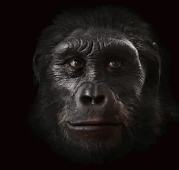Evolution
- It is the sequence, of gradual, irreversible changes which took place in the primitive organisms over millions of years to form new present-day species.
- Variations that resulted in formation of new species occurred basically due to errors in DNA copying as well as due to sexual reproduction.
First situation: Crows eat these beetles as they can easily pick up red ones in the green bushes There is a colour variation during sexual reproduction and green beetles appears, it reproduces and its population increases. Crows are not able to see green beetles so their population continues to increase but that of red beetles decreases. This type of variation gives a survival advantage.
Second situation: Due to a colour variation few blue beetle appear forming blue population. Crows can see both red and blue and eat them. Initially there are more of red beetles and less of blue. There is sudden calamity, an elephant kills red beetles by stamping on bush, blue beetles survive reproduce and increase in number. In this case there is no survival advantage but provides diversity without any adaptation.
Third situation: As the population of beetles increases, the bushes suffer from a disease and the availability of food for beetles decreases. The size of beetles decrease but after a few years as the plant disease is eliminated and enough food is available for the beetles they come back to their normal size. This type of change is not inherited.
Acquired Traits:
- Acquired traits are those which are not inherited over generations as they are caused due to change in the non-reproductive tissue and are not passed on the DNA of the germ cells for example; the size of the beetles in the population decreased due to scarcity of food.
Inherited traits:
- The traits that are inherited from the parents are called inherited characters.
- These traits always get transferred to the next generation, but depending on the dominance or recessiveness it may or may not be expressed.
- Examples are height, skin colour and eye colour.
Charles Darwin’s Idea of Evolution: His concept of evolution was based on the idea that new species were formed due to variations that occurred in the organisms Nature played an important role in selecting the organisms having suitable variations.
Speciation: It means the development of one or more species from an existing species The factors that could lead to rise of a new species are :
genetic drift: loss of alleles in small populations or Genetic drift is a change in the frequency of an allele within a population over time.
Natural selection:
- It is the phenomenon by which a favourable trait in a population of a species is selected.
- The species/organisms which are better adapted to the changing conditions survive and reproduce i.e. selected by nature and species/organisms which cannot adapt perish i.e. rejected by nature.
Homologous organs: Homologous organs are those which have a similar structure but different function. for example; Forelimbs of frog, lizard, bird, bat and human beings. They have same design of bones but they perform different functions.
- Wings of birds and forelimbs of mammals: they have similar structure but are modified to suit different functions
- A tendril of pea plant and spine of barberry plant: both are modified leaves, but perform different functions.
Analogous organs: Analogous organs are those which have a similar function but a different structure and origin too.
- Wings of bats, birds and wings of insects: both are used for flying, but structurally are very different
- Leaves of opuntia and peepal: both perform photosynthesis, but leaves of Opuntia are modified stem whereas peepal leaves are normal leaves.













No comments:
Post a Comment